Foundation Corner Popping- Wedge Cracks
. . . . on your San Antonio area SLAB FOUNDATION Besides just patching the pop off with a cement product when repairs are needed a method of repair would be to dowel in some rebar depending on the size of the corner popping and the condition of the concrete. Also a bonding material should be used and/or epoxy. Many times with minor corner popping rebar being doweled in is not an option.
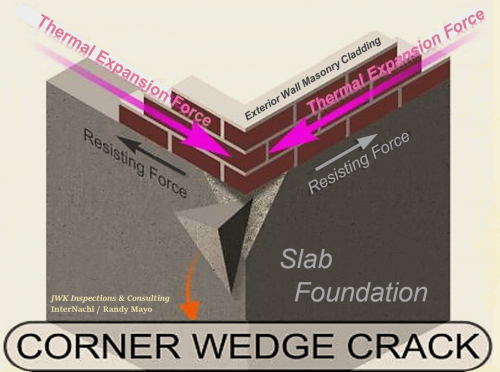
Brick expands due to thermal expansion and due to water absorption. A slab foundation in many cases is quite a bit underground and may have less or minimal exposure above ground while being less porous than brick, therefore making it much less expansive. The stress that develops is between the brick mortar below the bottom bricks (or stone) and the top of the concrete. Concrete with around 3000 PSI compressive strength may only have around 300 PSI tensile strength. The forces caused by the brick expansion can easily exceed this causing the corner to wedge crack or pop off. As the brick expands the concrete slab foundation tries to resist this expansion. This puts the brick in compression and the concrete foundation in tension. Concrete is very weak in tension but brick is very strong in compression, so the concrete loses and the corner cracks. 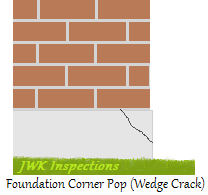 The cracks that develop from corner popping of a slab are a result of shear stress at the cold joint between the brick mortar joint on the concrete surface of the slab foundation. Because veneers such as brick walls expand and concrete foundations shrink, differential movement will cause shearing stresses when these materials are bonded together. A bond seperation like heavy duty plastic moist stop material on the brick lug (masonry ledge) or any other type flashinglike metal between the stone or brick work and the concrete slab surface will serve that purpose if properly initialy installed and maintained during construction as it will permit movement to occur without damage to the structure, as cosmetic as it may be or maybe even more significant in some cases. See proper and improper (moist stop) flashing seperation below,
The cracks that develop from corner popping of a slab are a result of shear stress at the cold joint between the brick mortar joint on the concrete surface of the slab foundation. Because veneers such as brick walls expand and concrete foundations shrink, differential movement will cause shearing stresses when these materials are bonded together. A bond seperation like heavy duty plastic moist stop material on the brick lug (masonry ledge) or any other type flashinglike metal between the stone or brick work and the concrete slab surface will serve that purpose if properly initialy installed and maintained during construction as it will permit movement to occur without damage to the structure, as cosmetic as it may be or maybe even more significant in some cases. See proper and improper (moist stop) flashing seperation below,
.
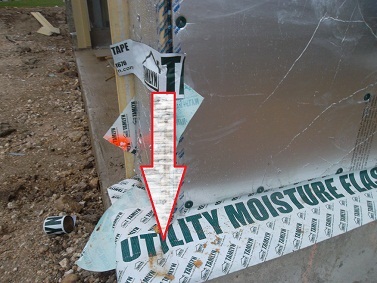
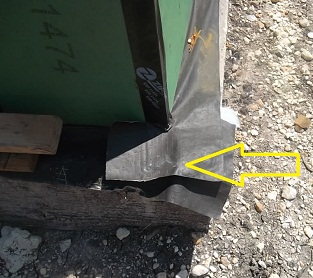
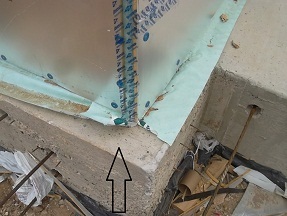
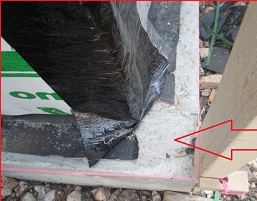
(4 photos above)- Are of San Antonio area Construction Framing Inspections. The upper 2 photos show proper brick lug (ledge) seal with moist stop flashing. The lower 2 photos (above) show improper installation of Moisture Flashing (Moist Stop) on the corner of the brick lug. This could have led to future corner popping but was corrected by the Builder due to the inspection report. This shows another reason for Construction Phase Inspections- to verify proper construction techniques are used. Proper seperation of the brick (or stone) mortar to the foundation will help prevent bonding of the masonry to the slab which in turn greatly reduces the chances of corner popping.
The closer you get to the corner of the foundation the greater the brick forces are and less for the foundation which creates the possibility of corner wedge cracks that can most likely be controlled by proper flashing seperation on the brick ledge from bonding to the mortar of the brick ors tone.
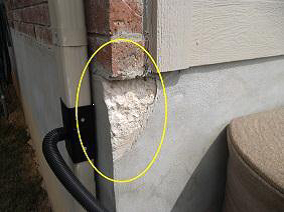
Every case is different and the corner popping cracks have to be put in perspective with everything else when determining if a repair is warranted. Most slab corner popping situations are not significant and shouldn’t be of concern. Even though the slab foundation and the masonry of the home are part of the structure of the home this occurrence of corner popping is not usually a structural problem. The significance of any cracks will help determine whether structural issues are of a concern.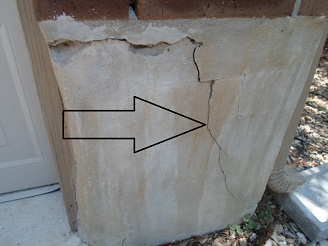
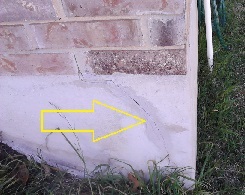 The photos at left show wedge cracking at two foundations. The one at the right has had some patching attempts and the crack appears to have continued into the mortar joint of the brick work.
The photos at left show wedge cracking at two foundations. The one at the right has had some patching attempts and the crack appears to have continued into the mortar joint of the brick work.
Previous home inspections here in the San Antonio area have shown stone and mainly brick veneers with large exposure or possible future excessive exposure due to corner popping without any obvious cracking or structural effects to the masonry and/or joints above the foundation. This is a sign of good mortared brick or stone that is usually very strong and can take a good deal of movement and wear and tear. Excessive movement can and will occur before any significant failure occurs to a brick or stone veneer on a home of a South Texas slab foundation that is designed for the shifting, expansive soils. Your brick or stone veneer installed on the brick lug of a slab foundation is not structural but is simply a veneer tied to the structural frame with wall ties that should be installed at 2 foot by 2 foot staggered intervals. This masonry veneer will however be affected by any structural problems of the foundation and also by significant issues of the framed structure.
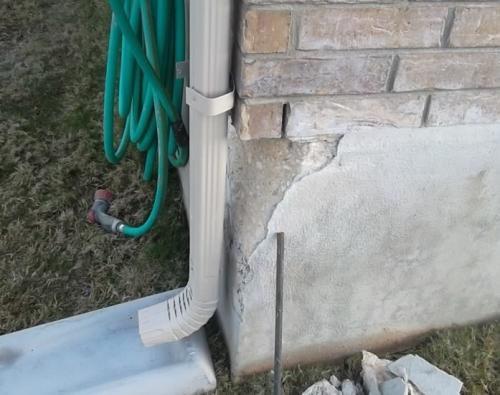 Photo shows an excessive corner pop off about to be repaired with rebar going to be doweled in for the repair. This was at a San Antonio area home less than a year old that JWK Inspections performed a Warranty Home Inspection on. The corner pop off here, as seen was more significant than in the photo of the foundation above. The builder here repaired the problem under warranty. There was no cracking in the brick or mortar joints above the corner popping at this time but preventive measures were taken with repairs honored by this builder under the warranty period. This of course validates the reason for a new home to have a warranty inspection before the one year period of warranty expires.
Photo shows an excessive corner pop off about to be repaired with rebar going to be doweled in for the repair. This was at a San Antonio area home less than a year old that JWK Inspections performed a Warranty Home Inspection on. The corner pop off here, as seen was more significant than in the photo of the foundation above. The builder here repaired the problem under warranty. There was no cracking in the brick or mortar joints above the corner popping at this time but preventive measures were taken with repairs honored by this builder under the warranty period. This of course validates the reason for a new home to have a warranty inspection before the one year period of warranty expires.
In conclusion, corner popping or wedge cracks are not a structural issue at least not at first, but should be monitored. If cracking continues at the slab corner and actually totally pops off and if it affects the masonry above it, it needs to be addressed as it may be from excessive shifting, movement.
Special thanks to contributing information by Randy Mayo - InterNachi Certified Inspector and Licensed Engineer
Info and Photos thruout by JWK Inspections at San Antonio area Home Inspections
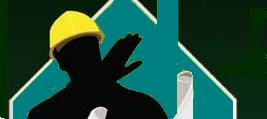





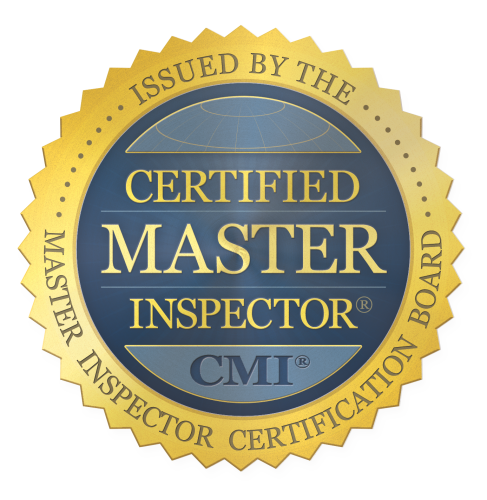


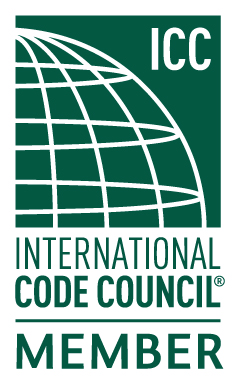











Post new comment